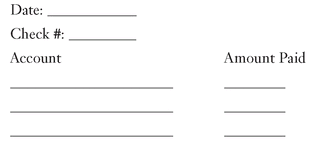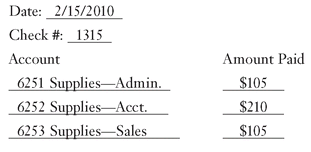Tracking General Expenses
,When we first designed the chart of accounts, the greatest number of individual accounts was in the expense category. This category included accounts for things such as rent, utilities, interest expenses, insurance, office expenses, and supplies and vehicles, as well as expenses related to employees, contractors, and professional advisors. (Part 3 of this book covers employee-related expenses in much greater detail.)
First, let’s look at the operating expenses and how you should record them. When your staff members pay bills for the business, they will code each bill for the account or account numbers that will be charged for the expense. For example, you may need to pay a bill from Office Depot that includes office supplies for several different departments. To track how much each department is spending on office supplies, you need to record portions of the bill in several different expense accounts.
Whereas accounts in accounts receivable have sales slips that already show the accounts and their codes, you need to come up with a system to code expense accounts. Many companies have a stamp that indicates the date the bill was paid, the check number, and blank lines to fill in the account code and amount. The stamp might look something like the following.

Let’s practice using this type of system with a bill from Office Depot for office supplies that includes $200 for the accounting department, $100 for the sales department, and $100 for the administrative offices. The sales taxes are 5 percent, or $20 for a total bill of $420. You need to allocate these expenses to the departments. The Supplies account number on the general ledger is 6250. You then need to assign numbers to each department. For example, give the Administrative Offices account number 6251, Accounting 6252, and Sales 6253. With the stamp, the Office Depot bill would be coded this way.

You can see that not only were the costs of the actual supplies allocated to each of the departments, but the taxes were also allocated based on the expenses. If the bill had included delivery or other charges, those, too, would have been allocated to the receiving departments.
With the information collected on this stamp, the person responsible for entering the information into the accounting system would have all he or she needs to develop the journal entry. The journal entry to record the payment of this bill would look like the following.

You decide how detailed you want to be when tracking your general expenses. Some businesses have one supply closet and assign one or two people the responsibility of managing the use of those supplies. These businesses probably do not have a separate account tracking each department’s supply use. Other businesses decide they don’t want to keep that kind of detail and just have one office supplies account and code.
If postage or shipping is a major expense of your business, you may want to track those expenses by department, or you could just have one expense account. Some businesses, such as construction, code every utility bill to the individual job site, but most businesses don’t bother to break down that bill at all.
In addition to allocating the expenses of bills paid, an accounts payable manager’s key responsibility is to be sure the bills are paid on time to avoid any penalties or interest charges. Also a well-managed accounts payable department can save the company a lot of money by being certain that bills are paid in time to receive any discounts offered for prompt payment.
A good way to manage bill payment is to have accordion files in which bills are placed as received. One file includes the months of the year, and a second has slots for days 1 to 31. As bills are opened, they are stamped on the day received and filed according to the month in which they must be paid.

BIZ TIPS
If approval is needed before payment, a copy of the bill should be put in the file to remind the staff a bill is due, and the original should be circulated for approval. Generally, to avoid the possibility of paying a bill twice, it is a good practice to pay bills based on only originals.
At the beginning of the month, all the bills to be paid in that particular month are transferred to the second accordion folder based on the day within the month those bills should be paid. Each morning the accounts payable clerk or clerks pulls the bills from that day’s folder in order to pay them on time. For example, if you have determined it takes five days from the time a check is sent for it to be recorded by your vendor as paid, then you would put something due on the tenth of the month in the day five folder.
If you use a computer system, your staff enters the bill into the system on the day it is received using the appropriate accounts to be charged and indicating the date the bill should be paid. If you use a purchase order (PO) system, the accounts payable person matches the invoice or bill to the appropriate PO. If the totals billed do not match the PO, the accounts payable person needs to send the bill through the appropriate approval channels before paying the bill.
Each morning someone is responsible for printing a report of the bills due for payment that day. Checks are written or computer-generated to pay those bills. The checks are then passed to the person responsible for reviewing the payments to make sure they have full approval and match the amount due; the responsible party then signs the checks. Signed checks are then passed to the person who sends them out. (Remember that having more than one person involved in the process of cash being disbursed from your business helps to prevent theft and embezzlement.)
..................Content has been hidden....................
You can't read the all page of ebook, please click here login for view all page.
